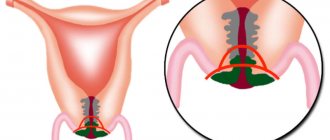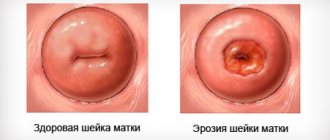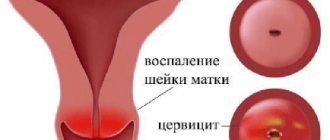Navigation:
- More details
- Does it hurt to do
- Cauterization of cervical erosion
- Cauterization of cervical erosion
- Cauterization of cervical erosion
- Chemical coagulation
- Cauterization for nulliparous or
- Recovery after cauterization
- How much does cauterization cost?
Below we will take a closer look at how cauterization of cervical erosion is done (specifically about each method), whether it is a painful procedure, how long it takes, what the consequences of this or that treatment method are, and how much it will cost.
Recovery period
The duration of the recovery period depends on the treatment method used and ranges from 1 to 2.5 months.
During this time, you should adhere to the following recommendations:
- abstain from sexual activity - sexual intercourse can only be started with the permission of a doctor, after a gynecological examination, using condoms;
- do not overheat - a woman should not visit baths and saunas or take hot baths;
- do not swim in pools and open water;
- do not lift heavy objects - light sports are allowed 2-3 weeks after treatment is completed;
- observe the rules of personal hygiene - do not use tampons, change pads on time;
- monitor possible discharge;
- undergo preventive examinations with a gynecologist at least twice a year.
Perhaps the gynecologist will recommend additional drug therapy to speed up recovery.
Leave a request or call 8 (800) 551-99-03 to make an appointment with AltraVita specialists.
Is it painful to cauterize cervical erosion?
It is impossible to give a definite answer to this question.
Whether a procedure is painful or painless depends on a number of factors. These include: the choice of treatment method, the patient’s pain threshold (sensitivity), the “size” of the erosion itself, etc. In most cases, during cauterization, local anesthesia is used, which “stops” all pain. Full anesthesia is not required. To questions from our patients like “I have cervical erosion, I’m about to have cauterization, will it hurt?” we answer without a doubt: it won’t hurt! Some sensations of discomfort may occur, but in this case this is the “maximum”.
Preparation for the procedure and possible contraindications
If a woman is prescribed treatment for erosion using the cryodestruction method, then no special preparation for this procedure is required.
Typically, cauterization with liquid nitrogen is performed a few days after the end of menstruation, and it is important to simply tune in to a favorable outcome. After the procedure, a woman usually experiences heavy discharge, so it is recommended that you take a sanitary pad with you. Such discharge usually bothers women for a month during the recovery period after the procedure. Treatment of cervical erosion by cryodestruction is not recommended in the following cases:
- During pregnancy;
- During menstruation;
- If there are injuries of various types on the neck of the reproductive organ;
- If the size of the eroded area of the mucous membrane exceeds 3 cm;
- With the development of inflammatory diseases.
When a woman is diagnosed with a large lesion on the cervix, treatment with liquid nitrogen is not recommended, since the results are rarely effective.
In this case, it is recommended to eliminate the pathology using other methods that are used in gynecology.
Cauterization of cervical erosion with laser
Laser therapy is a relatively new modern method of treating erosion, which is considered the least dangerous, gentle and one of the most effective. The essence of the procedure is as follows: damaged tissue cells are subject to targeted laser action, and more specifically, they heat up and evaporate without a trace in a matter of seconds. The depth of destruction is completely controlled (modern lasers have all the necessary settings), and no scars remain.
As a rule, cauterization of cervical erosion with a laser (reviews, consequences indicate this) allows you to completely and permanently get rid of the disease. Repeated treatment is possible in extremely rare cases (for example, a new erosion has occurred in another area).
Complete healing occurs in 2-3 weeks. Yes, when using a laser, everything heals very quickly, much faster than with other “options” of destruction. If we talk about the price of the procedure, in the DECA clinic the cost of cauterization of cervical erosion with a laser is 19,000 rubles.
For most patients, the procedure is virtually painless. But with increased sensitivity, there is a feeling of slight nagging pain in the lower abdomen during the procedure and a couple of hours after.
Advantages of the procedure and its disadvantages
Treatment of erosion of the cervix of the reproductive organ by the destruction method is considered an effective method of eliminating pathology and its following advantages can be highlighted:
- The procedure itself takes only a few minutes and after its implementation no negative consequences develop. After cauterizing the eroded areas of the cervix of the genital organ with liquid nitrogen, a woman can return to her normal life and not limit herself to anything.
- During the procedure, pathological areas of the mucous membrane are frozen, so the appearance of blood is excluded.
- Treatment of erosion using cryodestruction is recommended for nulliparous patients, since it does not cause tissue scarring and various complications.
- Numerous reviews from patients indicate that the cost of cryodestruction is low.
- Usually, after cauterization with liquid nitrogen, unpleasant consequences and complications do not arise.
Medical practice shows that recently, treatment of pathology of the cervix of the reproductive organ using cryodestruction has become less common and is explained by some disadvantages of the procedure:
- The main difference between cryodestruction and other methods of eliminating erosion is the long healing period, which is approximately several months;
- Cauterization of cervical erosion with nitrogen may be accompanied by the appearance of pain in a woman and most often this is determined by her sensitivity threshold;
- Treatment using the cryodestruction method can lead to incomplete removal of the pathology and subsequently it will be necessary to re-cauterize the erosion
- If the eroded areas are unevenly located on the neck of the reproductive organ, during the procedure, healthy tissue may be injured, which in the future can cause unpleasant consequences during pregnancy and labor.
- After the procedure, copious discharge may appear that has a specific odor;
- The recovery process continues for several months and during this time it is not recommended to use tampons;
- For 3-4 weeks the woman is forced to give up sexual activity.
After treating erosion with cauterization with liquid nitrogen, the consequences are mainly manifested in the formation of scars, however, this is quite rare.
Cauterization of cervical erosion with radio waves
Radio wave cauterization of cervical erosion, like a laser, involves a non-contact effect on the affected cells. High-frequency radio wave energy is used for treatment without thermal effects. The radio wave stimulates the internal energy of damaged epithelial cells, due to which water molecules “evaporate” and the cell evaporates.
Radio wave treatment is quick and painless. Subsequently, no scars or scabs remain on the cervix (abrasions due to clotted blood, crusts on the surface of the wound). There may be some slight bloody discharge. Complete healing occurs in 3-6 weeks. This technique is also recommended for nulliparous women. Many reviews have been received about cauterization of cervical erosion with radio waves: the likelihood of complications is low, but still slightly higher than when using a laser (here there are practically no complications if the doctor’s recommendations are followed).
Treatment
The main method of treating cervical erosion is cauterization.
Erosion treatment can be contact or non-contact. In the latter case, diseased cells are destroyed at a distance. After cauterization, a scab or crust forms at the site of cervical erosion, and the pathological cells die. Some time after cauterization of the erosion, the scab is rejected, leaving behind an area with healthy epithelium. Today, the following types of cauterization of cervical erosion are used:
- diathermocoagulation;
- cryodestruction;
- laser treatment;
- chemical treatment;
- radio wave coagulation (or radio wave treatment);
- argon plasma ablation.
The method of cauterization of cervical erosion is chosen by the attending physician, based on the clinical picture of the disease, data from additional examination methods, and the individual characteristics of the patient.
Diathermocoagulation
Diathermocoagulation, or electrocoagulation, is a somewhat outdated, but accessible and still used method for treating cervical erosion. When using it, erosion is treated with electric current. Under the influence of heat, pathological tissues coagulate, leaving a scab at the site of pathological changes. The duration of the procedure is about half an hour. Local anesthesia is used for pain relief.
Recovery after diathermocoagulation takes from 1 to 3 months. In some cases, pain is possible, for which the doctor will prescribe painkillers.
The main advantages of the method include:
- low cost;
- high efficiency;
- simplicity and high speed of the procedure.
The disadvantages include:
- long healing process of the wound surface;
- painful manipulation;
- high risks of complications, in particular wound infection;
- possible bleeding;
- formation of scars from connective tissue.
As a rule, diathermocoagulation is prescribed to women who have given birth and do not plan to have more children.
Cryodestruction
During cryodestruction, cervical erosion is treated with liquid nitrogen. In this case, the damaged tissue is frozen. The method is gentle, does not cause pain or bleeding, and healthy cells are minimally affected when used. Cryodestruction is a very effective method of treating erosion. The processing time takes only 5 minutes. The method is painless and can be used by nulliparous women.
Disadvantages of cryodestruction:
- high risk of damage to a healthy area of the cervix due to the inability to control the depth of exposure;
- watery vaginal discharge during the recovery stage;
- long process of postoperative observation;
- relatively high probability of relapse and the need to repeat the procedure;
- cannot be used if there is erosion with a diameter of more than 3 cm.
The duration of recovery after cryodestruction is 5-10 weeks.
Laser therapy
During laser cauterization of erosion under the influence of a unidirectional beam of light photons, pathological cells literally evaporate. In their place, a thin crust remains, which falls off over time, leaving behind a healthy area. The treatment is carried out under colposcopic control, due to which healthy tissue is practically not affected. Healing occurs quickly and without pathological symptoms. Scars do not form at the site of former cervical erosion. The laser beam reduces the activity of the inflammatory process and improves blood circulation in the tissues of the cervix. The technique is relevant for girls who are planning to have children in the future. The risk of relapse after treatment with a laser beam is minimal. Recovery time is up to 6 weeks.
Chemical coagulation
Chemical coagulation is used for minor erosions of the cervix. This method is cheap, gentle, and suitable for nulliparous girls. For cauterization, preparations containing acid are used. The cervix is treated with a medicinal agent, after which the woman can go home. After chemical treatment there are no scars and no bleeding. The disadvantage of chemical coagulation is that it cannot be performed for erosions more than 1 cm in diameter; individual intolerance to the drugs is possible.
Radio wave coagulation
Radio wave coagulation of erosion is a relatively expensive method, but one cauterization is sufficient for complete treatment. The method does not cause bleeding, is painless, and does not leave rough scars on the cervix. The essence of the method is to treat erosions with high-frequency radio waves. Under the influence of heat, pathological cells evaporate, and a thin crust remains in their place. Healing of the wound surface lasts about a month. The duration of the procedure is up to 20 minutes. During the recovery stage, minor discharge is possible, which goes away on its own within a week.
Advantages of the method:
- minimal damage to healthy tissue;
- absence of scars;
- painlessness;
- very low likelihood of complications;
- short duration of the procedure and recovery period;
- possibility of use by nulliparous women.
The method has only one drawback - the relatively high price.
Argon plasma ablation
This treatment method uses argon, which acts on the epithelium from a distance of 5 mm. Electromagnetic waves heat and cauterize abnormal cells. The cauterization depth does not exceed 3 mm. Instead of a scab, a thin crust forms at the treatment site, making the recovery process quick and painless.
Cauterization of cervical erosion with liquid nitrogen
The essence of the cryodestruction method: a stream of liquid nitrogen comes from a special cryoprobe, which destroys tissues affected by erosion through the use of extremely low temperatures (freezing followed by cell death).
The area of influence is selected extremely precisely, healthy tissues are practically not affected. No scar is formed. The procedure lasts about ten minutes. It is painless and can only “pull” the lower abdomen a little. Not accompanied by unpleasant odors. Immediately after cauterization, you may feel a little dizzy.
The method is bloodless and quite gentle. There may be a watery discharge for a couple of weeks. Complete healing occurs in approximately six weeks. In certain cases, the method may be recommended for nulliparous women (for example, when there is a need for cauterization, and laser or radio wave cauterization is contraindicated). But this technique is not applicable for deep erosion; sometimes a repeat procedure is required.
Cauterization for nulliparous women or during pregnancy
Among lovely ladies, there is a widespread and somewhat naive opinion that treating erosion before and during pregnancy is contraindicated. It's a delusion. Modern treatment methods make it possible to treat erosions at any time. The only limitation: you cannot be treated with a method that leaves postoperative scars.
Why does erosion need to be treated before childbirth? Erosive damage to soft tissue can prevent the cervix from dilating freely during labor. Due to damaged tissue, it may not stretch well and even tear. Therefore treatment is necessary.
This excludes methods with such consequences as fusion of the cervical canal, severe damage to healthy tissue, scar formation, and spontaneous dilatation of the cervix. That is, the most optimal options are laser and radio wave cauterization.
Recovery after cauterization
The listed moxibustion procedures are mainly carried out at the beginning of the menstrual cycle. In order for further recovery to be successful and without complications, until complete healing the patient is prohibited from:
general overheating, exposure to the open sun;
· taking baths, visiting the pool, sauna, swimming in open water;
· sexual activity;
· use of tampons;
Physical activity, especially weight lifting and strength training.
The recommendation should be followed strictly, regardless of the method used to treat erosion. Otherwise, the doctor cannot guarantee a positive result and exclude negative consequences.
How much does cauterization of cervical erosion cost?
The cost of treating erosion will depend on the method. DECA clinic specialists try to select several treatment tactics for each patient, recommending the most optimal one in each case. And, by the way, expensive laser or radio wave cauterization is not always recommended. If erosion is in its initial stage, conservative treatment is sufficient (an effective regimen costs only 1,500 rubles).
Make an appointment and come! The doctor will tell you in detail about your women's health and recommend effective treatment.
Be healthy and take care of your women's health!











